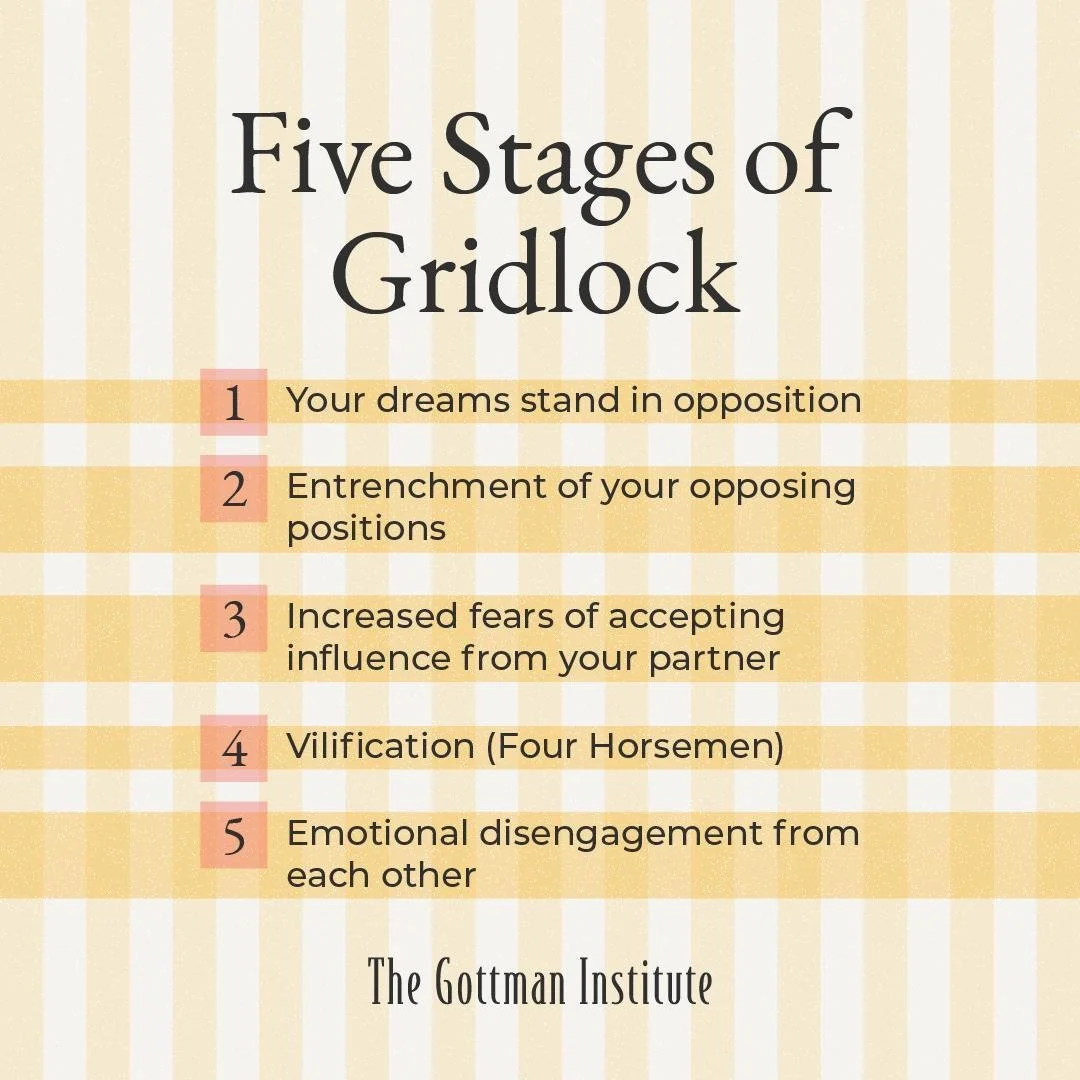There Are Only 3 “Conflict Styles” That Are Actually Healthy. Is Yours On The List?
by The Candidly Team
“I don’t want to fight,” is a very common thing said by couples clearly about to go at it.
But a more honest statement might be that we do want to fight - just in our own way.
After all, most of us want to resolve conflict. To express our point of view. State our feelings. To feel seen and heard by our partner. To reach some shared conclusion. Some return to closeness.
The trouble often is that we just aren’t connecting in these moments of tension, and maybe that’s because our conflict style is different than that of our partner.
Turns out according to acclaimed couples research team Julie and John Gottman, there is a way to fight right. They even just released a book with that exact title. “Most of us blunder into conflict without knowing what we are really fighting about and then quickly become overwhelmed by physiological responses we can’t control and emotions we don’t anticipate,” they wrote. “The truth is the happiest and most successful couples fight—all the time.”
So how can we learn a better way to fight? Or maybe 3 better ways to fight?
We talked to The Gottman Institute’s Clinical Director, Dr. Don Cole, and their Director of Research, Dr. Carrie Cole, (who happen to be a married couple themselves) all about how we can learn the right way to resolve conflict by better understanding our fighting style.
1) Can you go through each of the 3 conflict styles that are actually helpful to ensuring couples fight in healthier ways with better outcomes?
There are 3 conflict styles that have been shown to be stable conflict styles: avoidant, validators, and volatile. However, these are not bucket categories, they are more of a continuum of styles.
1. Conflict Avoidant Couples: There are some individuals who would just rather not engage in any conflict discussions. When differences come up, they tend to skirt around them, and politely agree to disagree. Conflict is uncomfortable for them, and they don’t see the point in causing instability in the relationship.
The upside: These couples are often very respectful of one another and focus on the good times that they have together. When they hit upon an issue that is a hot topic, they instantly drop it. These couples tend to have a lot of separate spaces within their home and may have very clear-cut divisions of labor within their households.
The downside: Some avoidant couples may calmly talk about some of their differences, but then they drop the conversation without any attempt to resolve it or explore it in any depth. The motto seems to be peace at all costs. Sometimes the cost is connection. The danger is that they may drift apart and end up living parallel lives with little to no real intimacy.
2. Validator Couples: These couples are interested in working through their differences. They want to talk about their conflicts, albeit quietly and respectfully, with the goal of working through them to some sort of resolution. They debate with one another. They accept influence from one another, meaning they listen to one another’s perspectives and accept those perspectives as valid and worthy of consideration.
The upside: While they may express some emotion, they tend to be very logical in their approach to conflict. They seek compromises to their conflicts. However, they avoid escalation and will switch into some collaborative effort to calm things back down, such as summarizing the other person’s point of view.
The downside: Validators would rather give up their position rather than risk a heated, volatile eruption. They may give up too much for the sake of a solution and harbor negativity about their partner.
3. Volatile Couples: These couples are very comfortable expressing their emotions and having heated debates over their conflicts. They see conflict as natural and normal, and some may even enjoy engaging in the heated discourse. They may raise their voices and become very emotional with one another. They often interject humor and positivity into their conflict discussions as well.
The upside: These couples tend to be passionate and have a lot of overlap in their roles and responsibilities in their household. They may enjoy arguing and see it as a healthy way to connect with one another.
The downswide: This style can be very stable; however, they can run into trouble if they lose their positivity, and each partner ups the ante with more negativity and aggression to win the fight. These couples can become contemptuous of one another if they lose their positivity.
As one might predict, couples often struggle when partners have different preferred conflict management styles. If an avoidant is in a relationship with a validator, one partner likely wants to discuss everything, and the other one never wants to talk about it. Either partner may become frustrated to the point of getting flooded and appear to be volatile in the moment, however, it’s a volatility that is painful and scary, perhaps to both individuals, which reinforces the avoidant’s beliefs that conflict is dangerous and should be avoided at all costs.
The same can be said of validator and volatile relationship combinations. The validator wants to talk about it, and the volatile passionately wants to express the opinions and maybe playfully poke fun at the other, which might cause the validator to immediately give up their position to keep the peace. The validator may then look like an avoidant.
2) Is fighting an inevitable part of every relationship? How can we tell if it's a sign things are entering more destructive territory?
In all relationships, couples have perpetual differences. For example, one partner may be very focused on saving money while the other is focused on using money for enjoyment and making memories. These differences are normal and should create a dialogue where both people feel heard, understood and that their needs are important to the other. However, many times, these ongoing differences lead to what we know as gridlocks. A gridlock conflict is the most destructive kind.
A gridlock conflict is:
repetitive in nature
rejecting of the partner’s point of view
escalating of negativity during discussions of the issue
People in gridlock become entrenched in their own position. They sometimes shut down altogether to avoid painful and seemingly pointless conversations about the issue. This creates emotional distance in the relationship which is not a good thing.
3) Knowing there's going to be some degree of conflict and that fighting tends to occur when people are already triggered and heated and not their "finest selves," how can a couple consciously decide to not spin out and try to fight in healthier ways?
Sometimes those upset feelings lead to physiological changes that we refer to as flooding. When people are flooded, they are definitely not their finest selves. And of course it's true that external stresses or triggers from the past can lead one into a heightened state which will more likely cause flooding to occur.
Most people, if they spend a few minutes thinking about it, can recognize the physical symptoms of flooding as they begin to occur.
For example, some people experience
their heart pounding
their mouths getting dry
their necks getting tight
a horrible feeling in the pit of their stomach
When flooding occurs, one’s frontal lobes, where their logic and communication skills reside, have temporarily gone offline. Attempts to converse and problem solve when one is in a state of flooding is futile and usually destructive, because the person is in a fight/flight/freeze response.
It is best for couples to decide ahead of time how they will handle moments of flooding when they occur. In our workshops we encourage couples to decide on a signal to inform their partner that a break is needed. A good break should last at least 20 to 30 minutes, and people must use that time to calm down.
The reconnection after the 30-minute timeout is an essential step.
4) This may sound silly, but are certain personality types better suited to different fighting styles? Is there a way to tell what approach might be best for us?
There are five common personality types reported in psychological research. These Big Five are:
Extroversion: characterized by talkativeness, assertiveness, and social engagement. They are friendly, comfortable being the center of attention, and are often action oriented
Agreeableness: characterized by a desire to get along with others, have social harmony, trustworthiness, honesty, empathy, and cooperation
Openness: characterized by open-mindedness, creativity, adventure, and enjoyment of philosophical ideas
Conscientiousness: characterized by self-discipline, diligence, and responsibility. These people are goal-oriented, hardworking, rational, cautious and want to see things through to the end
Neuroticism: characterized by emotional instability, moodiness, anxiety, irritability. They are perfectionistic, easily annoyed, seek reassurance, and can be confrontive
These personality traits also fall on a continuum and are not isolated buckets in which to put someone. We have each of these personality traits to varying degrees and can rate higher on one than the others.
It may be that those who are more extroverted might lean toward a validator or volatile conflict style.
Those who rate high on agreeableness may lean more toward an avoidant or validator style.
Those who rate high on openness may lean more toward a validator or volatile style.
Those who rate high on conscientiousness may lean toward either an avoidant or validator style.
Those who rate higher on neuroticism may tend to be more volatile.
We may have some natural tendencies toward one conflict style or another based on our personality traits. However, other factors contribute as well, such as our past experiences, from past relationships and from our family of origin. Some people make conscious decisions to do conflict differently than their families.
To manage that conflict effectively, it would be helpful to develop an awareness of each partner’s conflict style preference and discuss those conflict style preferences with one another. Be curious in those discussions.
How did each person come to believe what they believe about conflict?
What is their history with conflict?
How would they like to handle conflicts with each other?
How can each person feel safe with the other around conflict?
The whole point of conflict is to express one’s needs and longings, and to be understood. Underneath it all, we just want to be known and to believe that we matter to each other.
This interview has been edited for length and clarity.
This article is for informational purposes only. It is not intended to be used in place of professional advice, medical treatment, or professional care in any way. This article is not intended to be and should not be a substitute for professional care, advice or treatment. Please consult with your physician or healthcare provider before changing any health regimen. This article is not intended to diagnose, treat, or prevent disease of any kind. Read our Terms & Conditions and Privacy Policy.








